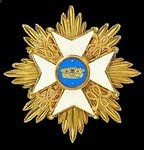The top flag is taken from the contemporary source showing Austrian flags as carried in the 1740s. The bottom two are hypothetical but quite possible Leibfahnen. Many Leibfahnen carried in the War of the Spanish Succession simply had the same pattern as the Ordinair-fahnen but with the main background colour of the flag as white. However, some also carried a small image of the Virgin and Child in a cartouche in the centre, as I have shown here in the final flag.
Wednesday, 1 December 2021
Sunday, 28 November 2021
Rossbach French Flags Project - Flags of French German Regiment La Marck
First raised 1680. Ranked 66th in the Seven Years War. 2 battalions.
This pattern of flags was carried from 1697-1791.
Text from Susane Volume 7 translated by me:
In 1756 La Marck was part of the auxiliary corps promised by Louis XV to the Empress [Maria Theresa] but France having had to take part on its own account in the Seven Years War, the regiment was called to the army of Marshal d'Estrées and was present at the battle of Hastenbeck. The volunteers, commanded by Captain de Nézot, found themselves attacking the rearguard of the enemy at Bielefeld and suffered greatly from the fire of the enemy artillery. The regiment then followed Marshal de Richelieu who came to replace the Marshal d'Estrées in Hanover. After the Convention of Closterseven the regiment was at the camp of Halberstadt which it left on the 7th October, to go to reinforce the army of the Prince de Soubise. It was crushed on the 5th November at Rossbach [the next part of the sentence does not seem to make much sense so I have omitted it]. Captains Mantz l'ainé and Limar, and lieutenants Hiem, Brancion, Druhot, Suty and Beurdhal lost their lives; captains d'Ayrolles, Trichard, Desbarreaux, Lescalier, Housseau, Grandchamp, d'Eblingheim, Mantz cadet, Desfossé-Solis, Dufort and Lyautey were wounded, as were the three aide-majors Carlier, Maës and Scheid, and seven lieutenants amongst whom were Monsieurs Montel and Baklau.
The remnants of the regiment retreated to the Rhine and when Prince Ferdinand had crossed the river at the beginning of 1758, they were ordered to throw themselves into Dusseldorf. La Marck found itself that year at the battle of Krefeld and the combat of Meer, where it took from the enemy a cannon which replaced the one it had lost at Rossbach.
La Marck does not seem to have been actively employed in 1759. On the 18th January 1760 it incorporated the 2nd battalion of the regiment of Lowendhal, which raised its strength to three battalions. On the 10th of July it was distinguished at the battle of Corbach and, at the end of the same month, it made a vigorous contribution to the attack on Cassel and on the camp of Sachsenhausen, which Prince Ferdinand was obliged to abandon. The same year Captain de Nézot, who had continued to distinguish himself at the head of a company of volunteer chasseurs, played a brilliant part in the taking of Minden and received the cross of Saint-Louis at the age of 23 years. During the winter La Marck took part in the attack on the lower town of Statsberg and in 1761 the battle of Wilhemstadt and all those actions which took place around Cassel. A regulation of 21st December 1762 reduced the regiment to two battalions.
After the end of hostilities, La Marck was sent into garrison at Thionville.
And this was the uniform in 1756:
Posted by
David Morfitt
at
Sunday, November 28, 2021
10
comments
![]()




















